This post is an overview of low and zero-VOC sheathing, decking, and subfloor options
This post contains affiliate links to relevant products that I use and recommend. Upon purchase, I earn a small commission at no extra cost to you.
Structural Plywood
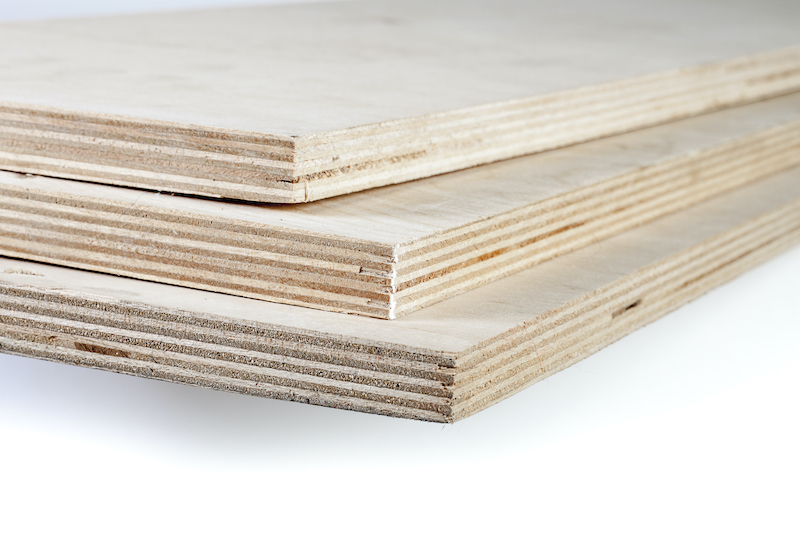
Structural plywood (Softwood Plywood – SWPW) can be used for exterior sheathing, roof decking, and subfloors.
It is made with phenol-formaldehyde glue (PF) in the US and Canada.
The Rate of Formaldehyde Offgassing in PF Plywood
“Formaldehyde levels in this test chamber were well below 0.1 parts per million (ppm) in the air from all tests of fresh panels, and emissions rapidly approached zero as the panels aged.
In fact, the levels were so low and so close to the “background” levels in the test chamber that it was not possible to measure them accurately.” APA Source
While 0.1 ppm is high for someone sensitive, the fact that the panels rapidly offgas makes them a safe option for most people with chemical sensitivities.
I would suggest testing plywood that is a few months old before ruling it out.
For a detailed review of the glues and chemicals that offgas from plywood and OSB sheathing see the post on formaldehyde and pressed wood products.
A Note on Purebond Formaldehyde-Free Plywood
Purebond plywood is not rated as a structural plywood for sheathing, subfloor, or decking. It also doesn’t handle moisture as well as typical plywood.
I have spoken to the company and they don’t recommend it used for this purpose though I do see people building with this product. Please don’t do this!
Purebond is made with “soy-based glue” which can be quite tolerable for the chemically sensitive.
Plyboo is a bamboo-based plywood made from soy glue as well and is also not structural.
Exterior Sheathing Options
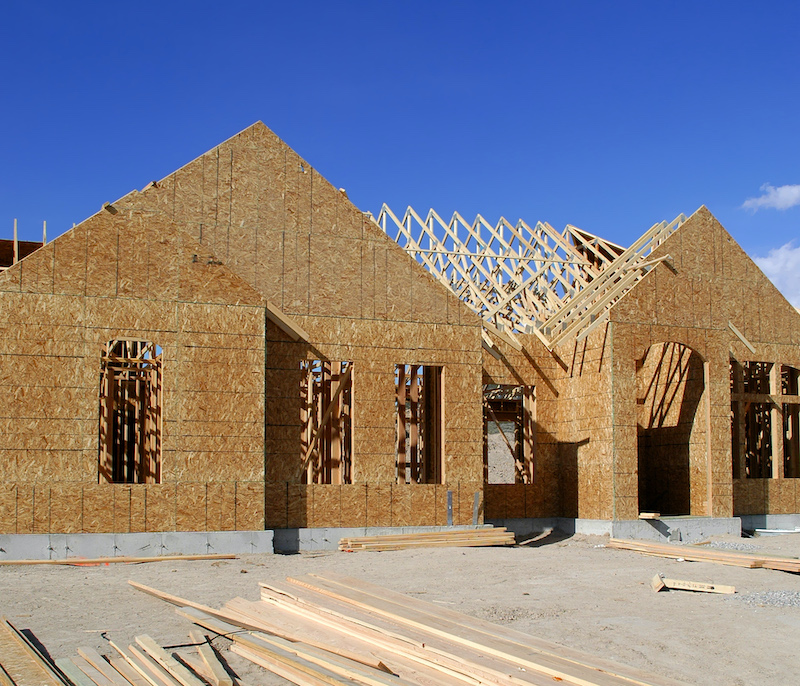
Plywood and OSB are the most common products for sheathing. If you use something else, the first thing you need to do is check with your building codes and also consult with an architect to make sure you have the structural support needed.
The three main types of sheathing are: plywood, OSB, and Huber’s OSB.
Plywood is the best option for most sensitive folks. OSB take longer to offgas. I have found that Zip Sheathing (a type of OSB) needs a solid 4 months (at least) to offgas. I like the Zip-R which is OSB-backed in polyiso foam. The foam is to the interior side, which seems to block the offgassing.
It’s highly unusual to use anything other than plywood or OSB.
Solid wood can be used but it’s very pricey and not done often. Non-wood options are far riskier.
Non-wood options are sometimes used but are usually unadvisable, often far more expensive, and often don’t meet codes: those include Georgia-Pacific DensGlass gypsum, MgO board, and even rigid foam can technically be used as exterior sheathing in some areas (though almost never advised by a good architect). Cement board is sometimes used, especially in tropical areas. USG Structural Panel is a thick, strong concrete board (unlike crumbly tile backer boards) that is sometimes used on foundation walls when the framing is metal. It has a slight odor but it is mild, I expect that it has polymers added since it has 10% undisclosed ingredients and a faint odor.
Consult with your architect or engineer before choosing an unusual product.
Subflooring
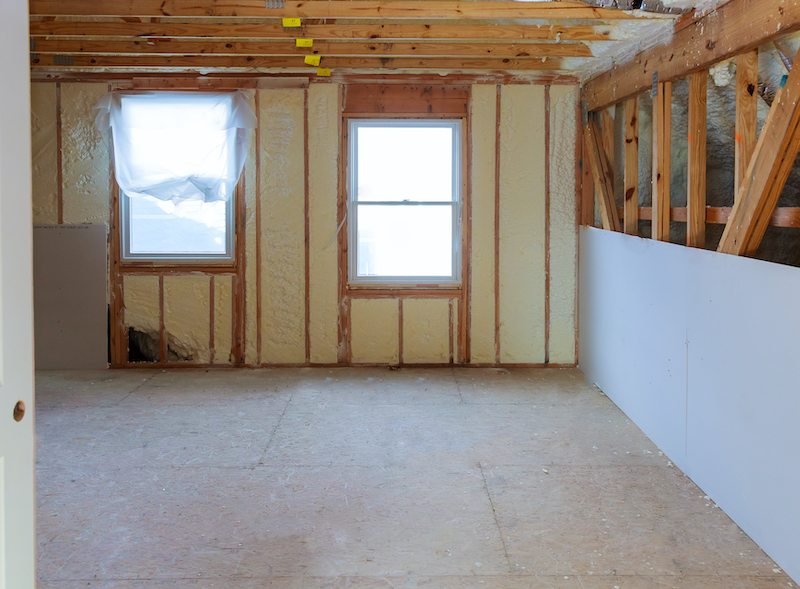
Subflooring is usually plywood, OSB, or Advantech (which is a form of OSB). Exterior grade plywood is generally the best choice for the chemically sensitive.
You can also use solid wood.
It is possible to use structural cementitious sheeting board (MgO) as a zero-VOC option however when I did this in my tiny house I needed additional framing support underneath.
You have to spec specific brands that have structural ratings. This is not something that has been in use for long, and it would be unusual to find a good architect who would approve this.
Huber did recently acquire a MgO board company that has a structural rating.
For those who can’t tolerate wood, it is possible to pour a concrete upper floor, though this is not usually done in North American homes. It’s more realistic to use USG Structural Panel Concrete subfloor.
Pre-Plywood Options
In the days before plywood, solid wood was usually used:
For exterior sheathing, 1-by lumber laid diagonally was used. This is not an airtight option so humidity and energy issues should be considered. Make sure to use house wrap. Consider double-sided house wrap tape so that you get more of an air barrier.
For subfloors, 1-by subfloor was laid diagonally to the floor joints. The subfloor could be planks or tongue and groove. Here is a pic of what a solid wood plank subfloor looks like.
This is a zero-VOC option but it will cost you quite a bit more. If you use this method make sure you use a subfloor adhesive otherwise you will have a very creaky floor.
Liquid Nails is the lowest VOC option I have seen at less than 20g/l, but I find Almighty Adhesive to be more tolerable.
For decking, 1x decking butted up to each other can be used. This is how roofs were built before plywood or OSB. This will allow for many types of roofing types over it.
Roof Sheathing (Decking)
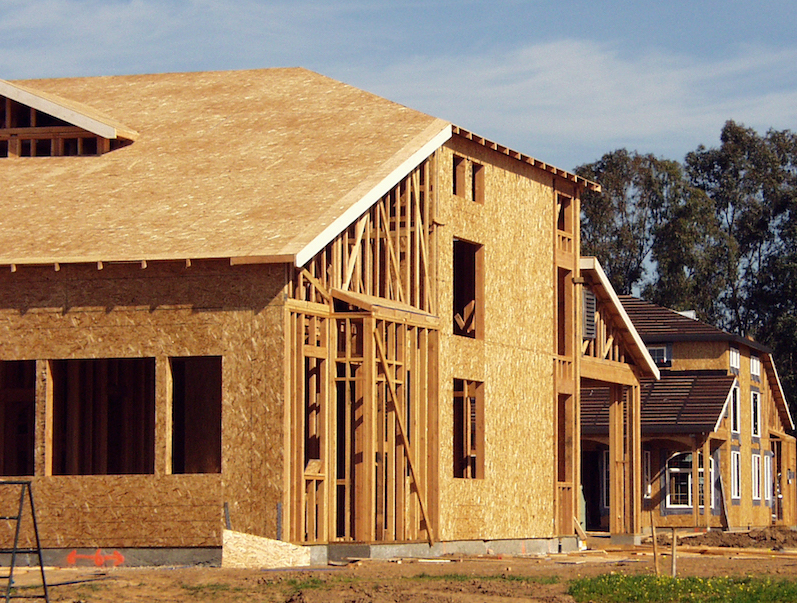
Plywood, OSB, and Huber products are also the most common roof decking.
Purlins or skip sheathing can be used as an alternative form of roofing which eliminates the need for solid sheathing. This will only work with certain roof types (metal vented attic, in some cases cedar) says Paula Baker-Laport, Architect.
Huber Advantech products are applied with a polyurethane adhesive. You would want to check for the tolerability of polyurethane adhesives (as well as the Advantech product themselves).
Corinne Segura is a Building Biologist Practitioner with 8 years of experience helping others create healthy homes.
Did you find this post helpful? If so you can buy me a coffee to support the research behind this blog. Thank you!
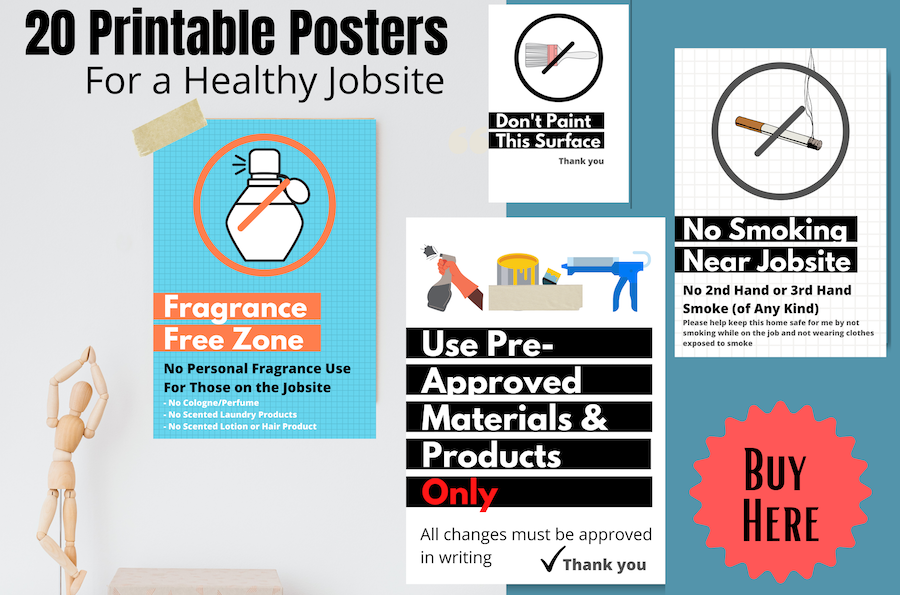

Simone Mellor
I am insulating and putting drywall up in my ADU garage conversion. The existing exterior walls are just the t1-11 siding and framing- no sheathing. My contractor recommended we use Pro Clima Aerosana Visconn to paint the insides of the siding and framework. Do you know much about this product and its offgasing?
-Simone
[email protected]
Corinne Segura
I don’t know anything about it but they may not list VOCs if it’s meant for the exterior. I would consult with Cheryl Ciecko on if this is a good idea as this is not a proper wall like in a house.
Simone
Thank you Corinne. I will reach out to her.
Joan
Corinne,
We are putting a new white oak floor in an apartment that had been owned by a smoker. I have MCS. The contractor went ahead and put in an Avantech subfloor without my knowledge. Will we need to pull it up and use a plywood subfloor or is it possible to off-gas the Avantech? Help.
Corinne
That depends on how sensitive you are. You have to go by your own reactions.
Joan
Thank you for your reply. It will be costly to pull up the Advantech subfloor and put in a new plywood subfloor. You had written elsewhere that it takes four months for Advantech to off-gas. Does it off-gas in that same amount of time once the floor boards are on top? After the four months with the floor boards on top, should it be okay? One option is for me to stay in my current apartment and move in after four months. In your reply to Kathleen in 2020 you had said that some people might find Advantech and plywood to be similar. I am not sure what to do. Thank you for your help.
Corinne
4 months is how long it took at my level of sensitivity which has been a useful gauge in the past for probably 90% of sensitive people. depending on what underlayment and flooring you put on top and what’s below it it will restrict offgassing to some degree and slow it down.
Dorothy M
Hi. I’m about to spend a boat load of money on having my house’s old stucco removed and the fiberboard (from the early 1980’s (possibly Celetex) removed. Then the building re-sheathed and re-stuccoed. The contractor wants to use OSB followed a waterproof membrane followed by a thin insulation board followed by lathe and then the cement stucco brown coat then color coat. I’m wondering: would Barricade Thermal Brace be more energy efficient and less toxic than either OSB or Plywood?
Corinne
I would not use a fiberboard sheathing
Brooke
Hi there!
You mention the Zip R sheathing system. Is this system typically tolerated by those with MCS? I see that it has foam, so I’m very curious. I know you do not like 2 part spray foam, so is the Zip system foam completely different and does it not off gas? I have MCS and considering the Zip R system with mineral wool insulation. Would the foam on the Zip R system be considered the vapor barrier?
Thanks so much! LOVE your site!
Corinne
the OSB part would not be tolerated by those with severe MCS, the foam does not really have any offgassing other than when you cut into it and a little is released from the closed cells.
Brooke
Thank you!
Does OSB take a long time to off-gass?
Would the foam on the Zip R system act as the vapor barrier if one were to use Rockwool, Havelock, or fiberglass batting?
Corinne
OSB does take some time to offgas. The polyiso is not technically a vapour barrie but it’s of such low permeance that it’s treated like one. You can make your dew point calculations as if it were.
Brooke
Thank you Corinne! I appreciate your advice and blog!!!
Paul
I’ve decided to use exterior grade plywood (CDX Exposure 1) as underlayment for wood flooring, Can you recommend a safe subfloor adhesive?
Corinne
In the adhesive post. AFM usually the way to go.
Jen
If exterior grade plywood (CDX Exposure 1) is used for underlayment for wood flooring, is it necessary to air it out onsite? If so, for how long? Should it be sealed with an acceptable vapor-barrier sealant or that unnecessary?
Do you recommend avoiding Advantech subflooring due to the adhesives?
Thanks for all of the information you provide!
Corinne
Whether you need to air it or seal it or not depends on your sensitivities. I wouldn’t do either, personally. Avantech has more offgassing even without the polyurethane sealants needed. So if you are at the level of considering sealing plywood that would be way worse.
Jenna
I made the mistake of painting my subfloor to get rid of pet odors before laying new carpet a couple years ago. Now I’ve developed tinnitus and I think it’s from the paint off-gassing through the carpet (carpet was tacked down, not glued). For peace of mind I want to just get rid of the paint. Do I need to completely replace the subfloor, or would a layer of visqueen prevent the chemicals from getting into the air?
Corinne
I doubt that paint is offgassing after 2 years but it is possible. I would use sealants if that this the problem. Check out the posts on sealing in offgassing.
Dean
I want to apply a water proof sealer to the Weyerhauser 3/4 inch edge-gold subfloor to repel water between the beginning of September and mid October to guard against the elements (rain) in case we get a early rain storm this fall. The house I’m building won’t have a roof and be dried-in until late October. Is there any low VOC sealer that you could recommend that I could apply by either brush or sprayer?
Daniel Parnell McCarter
When installing a plywood subfloor over a concrete slab, are adhesives or glues needed or used typically?
Also, do you think it would be worth painting the plywood subfloor with a non-toxic sealer (like from https://www.afmsafecoat.com/) to seal in the low amount of formaldehyde that is in the plywood?
Thanks!
David Duke
If I used Dennyfoil behind my drywall would that prevent the exterior plywood from off gassing into my home?
Corinne
Plywood offgasses quite quickly on its own. The danger of an interior vapour barrier like denny foil is condensation and mold in most conditions where AC is used.
David Duke
Thank you!
Kathleen Beine
You state that PF plywood subflooring is preferred over Advantech, but you don’t say why. Both products use phenol formaldehyde resins, and the amount of resin in each product is similar. Therefore, formaldehyde emissions from cured PF plywood and from Advantech should be similarly low. Both products, and other similar products, are considered by US Dept of Housing & Urban Development to be insignificant. Because their emissions are so low, these products are exempt from California Air Resources Board regulation. So, why do you prefer PF plywood over Adventech for those who are chemically sensitive?
Corinne
Advantech has PF and MDI glues. There is more glue the more the engineered product is made of smaller pieces. Advantech is more impregnated with resin which makes it more durable than regular OSB. Usually sensitive folks prefer plywood but you may find the two products similar or you may have a preference for one or the other. CARB focuses on interior wood products only not structural.
Unknown
I do not see any links?
misha
We used it as flooring on the 2nd floor of the house we're building. Also going to use as inside walling and outdoor decking with tiles over the top. We used Modakboard MgO board from Australia. Great company! Sent samples wrapped in foil for me and everything.
CriegerGoodwin
What about MgO Board? George Swanson, builder from Austin, TX, uses MgO for exterior applications as well as interior. I think he also uses it for roof sheathing… Thoughts?